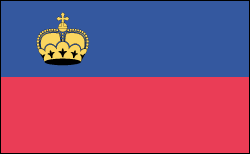LIECHTENSTEIN

Geography: Tiny Liechtenstein, not quite as large as Washington, DC, lies on the east bank of the Rhine River, south of Lake Constance, between Austria and Switzerland. It consists of low valley land and alpine peaks. Falknis (8,401 ft; 2,561 m) and Naafkopf (8,432 ft; 2,570 m) are the tallest.
Government: Hereditary constitutional monarchy.
History: The Liechtensteiners are descended from the Alemanni tribe that came into the region after A.D. 500. Founded in 1719, Liechtenstein was a member of the German Confederation from 1815 to 1866, when it became an independent principality. It abolished its army in 1868 and has managed to stay neutral and undamaged in all European wars since then. Liechtenstein still claims 1,600 sq km of Czech territory (the royal family's ancestral home) confiscated in 1918; the Czech Republic insists that restitution does not go back before Feb. 1948, when the Communists seized power.
In a referendum on July 1, 1984, male voters granted women the right to vote in national (but not local) elections.
Blacklisted in 2000 as a center for money laundering, Liechtenstein toughened its laws and made major efforts to clean up its financial practices. In 2002, the country was removed from the OECD's (Organization of Economic Cooperation and Development) blacklist.
In March 2003, their people overwhelmingly voted to give its prince more power, including the right to dismiss governments and approve judicial nominees. Prince Hans Adam II had threatened to leave the country if his demands for more authority were not met, though he already possessed more power than any other European monarch.
In Aug. 2003 the prince announced that he would give up the day-to-day ruling of the country in one year's time. In Aug. 2004, his son, Prince Alois, 36, became regent of Liechtenstein, while Hans Adam II remained the official head of state.
Klaus Tschuetscher won the absolute majority in parliamentary elections in Jan. 2009. He was sworn in as prime minister in March 2009.
On February 3, 2013, the Progressive Citizens' Party (FBP) won parliamentary elections with 40% of the vote. Adrian Hasler, FBP's candidate for prime minister, would be sworn in March 2013.
Government: Hereditary constitutional monarchy.
History: The Liechtensteiners are descended from the Alemanni tribe that came into the region after A.D. 500. Founded in 1719, Liechtenstein was a member of the German Confederation from 1815 to 1866, when it became an independent principality. It abolished its army in 1868 and has managed to stay neutral and undamaged in all European wars since then. Liechtenstein still claims 1,600 sq km of Czech territory (the royal family's ancestral home) confiscated in 1918; the Czech Republic insists that restitution does not go back before Feb. 1948, when the Communists seized power.
In a referendum on July 1, 1984, male voters granted women the right to vote in national (but not local) elections.
Blacklisted in 2000 as a center for money laundering, Liechtenstein toughened its laws and made major efforts to clean up its financial practices. In 2002, the country was removed from the OECD's (Organization of Economic Cooperation and Development) blacklist.
In March 2003, their people overwhelmingly voted to give its prince more power, including the right to dismiss governments and approve judicial nominees. Prince Hans Adam II had threatened to leave the country if his demands for more authority were not met, though he already possessed more power than any other European monarch.
In Aug. 2003 the prince announced that he would give up the day-to-day ruling of the country in one year's time. In Aug. 2004, his son, Prince Alois, 36, became regent of Liechtenstein, while Hans Adam II remained the official head of state.
Klaus Tschuetscher won the absolute majority in parliamentary elections in Jan. 2009. He was sworn in as prime minister in March 2009.
On February 3, 2013, the Progressive Citizens' Party (FBP) won parliamentary elections with 40% of the vote. Adrian Hasler, FBP's candidate for prime minister, would be sworn in March 2013.

Map of
Liechtenstein
Principality of Liechtenstein
Ruler: Prince Hans
Adam II (1989)
Head of
Government: Adrian Hasler (2013)
Total area: 62 sq mi (161 sq km)
Population (2014 est.): 37,313 (growth rate:
0.82%); birth rate: 10.53/1000; infant mortality rate: 4.33/1000; life
expectancy: 81.68
Capital and largest city (2011 est.):
Vaduz, 5,000
Monetary unit: Swiss franc
National name: Fuerstentum
Liechtenstein
Ethnicity/race:
Liechtensteiner 65.6%, other 34.4% (2000 census)
Religions:
Roman Catholic (official) 75.9%, Protestant Reformed
6.5%, Muslim 5.4%, Lutheran 1.3%, other 2.9%, none 5.4%, unspecified
2.6% (2010 est.)
National Holiday:
Assumption Day, August 15
Literacy rate: 100%
Economic summary: GDP/PPP (2009 est.):
$3.2 billion; per capita $89,400 (2009). Real growth rate:
1.8% (2012). Inflation: -0.7% (2012). Unemployment: 2.8%
(2009). Arable land: 21.88%. Agriculture: wheat,
barley, corn, potatoes; livestock, dairy products. Labor force:
35,830 note: 51% of the labor force in Liechtenstein commute
daily from Austria, Switzerland, or Germany (2010) ; industry 39.4%,
services 59.9%,
agriculture 0.8% (2012). Industries: electronics, metal
manufacturing, dental products, ceramics, pharmaceuticals, food
products, precision instruments, tourism, optical instruments.
Natural resources: hydroelectric potential, arable land.
Exports: $3.801 billion (2010): small specialty machinery,
connectors for audio and video, parts for motor vehicles, dental
products, hardware, prepared foodstuffs, electronic equipment, optical
products. Imports: $2.09 billion (2012): agricultural
products, raw materials, machinery, metal goods, textiles, foodstuffs,
motor vehicles. Major trading partners: EU (Germany, Austria,
France, Italy, UK), U.S., Switzerland (2004).
Communications: Telephones: main lines in
use: 20,000 (2012); mobile cellular: 38,000 (2012). Broadcast media:
relies on foreign terrestrial and satellite broadcasters for most
broadcast media services; first Liechtenstein-based TV station
established August 2008; Radio Liechtenstein operates multiple radio
stations; a Swiss-based broadcaster operates several radio stations in
Liechtenstein (2008). Internet
Service Providers (ISPs): 14,278 (2012). Internet users: 23,000 (2009).
Transportation: Railways: total: 9 km;
note: owned, operated, and included in statistics of Austrian Federal
Railways (2008). Roadways: total: 380 km (2012); paved: 380 km. Ports and harbors: none. Airports:
none.
International disputes:
none.
-------------------- o --------------------
No comments:
Post a Comment